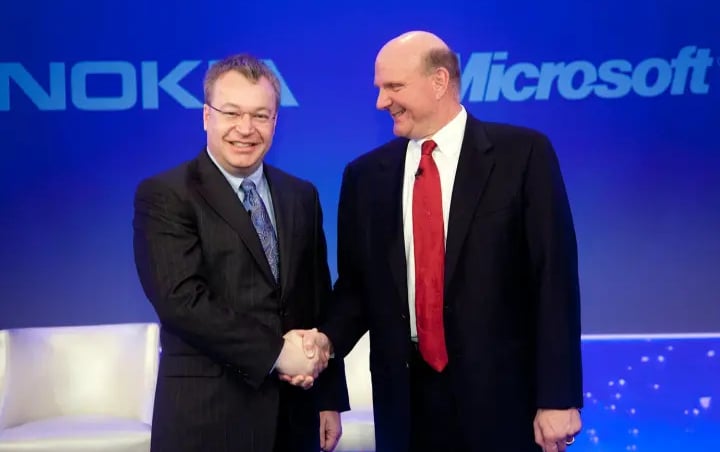Negotiation Lessons from The Nokia-Microsoft Deal
The negotiation lessons Nokia Microsoft deal reveal the consideration for considerations of BATNA and negotiation powers to concerns over potential conflicts of interests.
BATNANEGOTIATION STRATEGIESNEGOTIATION POWERS
Ashish Mendiratta
5/1/20244 min read


The Chronology of the Deal
2011: Nokia contemplated a divestiture strategy for its handset business, a notion underscored by prior sales trends and internal restructuring efforts. Conversely, Microsoft sought diversification, viewing entry into a new market with a novel product as an avenue for growth. This mutual pursuit of expansion led to Microsoft's initiation of acquisition talks, a move intriguingly timed just five months following Nokia's appointment of Stephen Elop, a former Microsoft executive, as CEO.
However, negotiations encountered an impasse, primarily revolving around the pricing of Nokia's handset business, leading to a recalibration of the relationship. Consequently, the collaboration shifted gears, narrowing its focus to joint product development endeavors, with Nokia concentrating on hardware and Microsoft on software, culminating in what was termed a "Strategic Partnership." This collaboration marked a significant milestone for both companies, as they aimed to challenge the dominance of Apple's iPhone and Google's Android devices in the smartphone market.
January 2013: Microsoft reopened discussions, reigniting negotiations with Nokia. The impasses encountered previously were chiefly attributed to disagreements over the price and ownership structure of Nokia's HERE mapping service. Meanwhile, the landscape of smartphone competition had intensified, presenting new challenges and opportunities. Despite two years having elapsed since the inception of the Nokia-Windows smartphone collaboration, the products had yet to achieve the desired level of success compared to their competitors.
This underperformance cast a shadow over the Strategic Partnership, which had not yielded the anticipated results for either company. For Microsoft, it became a "do or die" scenario, recognizing the imperative to penetrate the smartphone industry successfully. Concurrently, Nokia witnessed a drastic decline in its global market share, plummeting from 40% to 15% since the initiation of the partnership in 2011. These developments underscored the pressing need for strategic reassessment and decisive action from both parties.
September 2013: A landmark agreement was struck between Nokia and Microsoft. Under the terms of the deal, Nokia received €3.8 billion for its Devices & Services business, along with an additional €1.6 billion for a 10-year non-exclusive patent license agreement, totaling €5.4 billion or approximately US $7.2 billion. In exchange, Microsoft gained ownership of Nokia's handset business, along with nearly 40,000 patent licenses. Furthermore, Microsoft secured the status of a strategic licensee of the HERE platform. Notably, Nokia's CEO, Stephen Elop, agreed to rejoin Microsoft, entitling him to a substantial US $25 million bonus.
2015: The agreement, finalized in 2014, swiftly turned into a debacle for Microsoft: the company incurred a substantial write-off, virtually nullifying the deal's value, and in July 2015, it implemented widespread layoffs, impacting thousands of employees.
The Key Highlights of the Negotiation
1. BATNA (Best Alternative to a Negotiated Agreement): In the negotiation both Microsoft and Nokia had BATNA. For Microsoft, the BATNA was to have a deal with other handset players like HTC, Samsung or Huawei. On the other hand, Nokia's BATNA was to switch to Android operating system. Who had the stronger BATNA? Nokia seemingly had a stronger BATNA, given its strong technical expertise, it could have switched to an alternative platform if necessary. With a stronger BATNA, Nokia could walk away from an offer made by Microsoft that was below their expectations.
2. Powers in Negotiation: Microsoft powers included its prowess in software as well as their financial strength & resources. However, their weakness was the Windows was not a proven platform for the mobile devices. Additionally, Microsoft was in a desperate situation to make their mark in the smartphone segment. Despite their partnership over 2 years, they were not able to compete with Android & iOS platforms. Nokia's powers were their stronger BATNA, their established brand value in the handset market, and their technical expertise in hardware.
3. Value Claiming vs Value Creating: Nokia mostly adopted a "Value Claiming" approach as they focused mostly on the sale value as well as retaining exclusive rights to the Here mapping services. They were able to create a strategic partnership, one responsible for developing the operating system and the other for the hardware. However, Microsoft and Nokia were both investing marketing money to build separate brands and lure app developers. Engineering teams from the two companies were also duplicating efforts in some areas and unable to fully collaborate in others. In a nutshell, there was a little value creation through joint collaboration.
4. Potential Conflict of Interest: Stephen Elop, the CEO of Nokia, has been embroiled in several controversies. Notably, his past affiliations with Microsoft raised concerns about potential conflicts of interest. Moreover, Elop initiated acquisition discussions for Nokia a mere five months after assuming his role, prompting scrutiny over the timing and motives behind such negotiations. The company's downward trajectory since Elop's appointment further fueled speculation about his leadership decisions. Additionally, the revelation of Elop's substantial $25 million bonus amidst Nokia's turbulent financial situation stirred controversy, questioning the prudence of such remuneration.
The Shortcomings of the Negotiations
Delay in arriving at the agreement due to numerous deadlocks because each party held on to its position and prolonged the process.
The delays caused the value of the pie to become smaller and smaller. In the space of technology, time is the key essence. Had the agreement been reached earlier, both would have gained and prevented the value erosion over time.
Both the parties failed to exercise their BATNA and instead tried to chase a deal that lacked the common vision.
The immediate commencement of acquisition talks following Stephen Elop's recruitment from Microsoft should have been a glaring red flag, which unfortunately went unnoticed by the Nokia board.
Both Microsoft and Nokia ignored the changing environment and competition landscape emerging during that period.


Conclusion
In hindsight, the chronology of the deal between Nokia and Microsoft presents a compelling narrative of ambition, opportunity, and ultimately, missed potential. Throughout the negotiation process, several key highlights and shortcomings emerged, shedding light on the dynamics at play. From considerations of BATNA and negotiation powers to concerns over potential conflicts of interest, the complexities of the deal were manifold. Yet, amidst these complexities, one overarching lesson stands out: the importance of foresight and adaptability in navigating high-stakes negotiations. The delays, deadlocks, and oversights that characterized the negotiation process serve as cautionary tales, underscoring the imperative of proactive decision-making and strategic vision
Subscribe
Contact:
contact@advanchainge.com
+91-9873829286
deepak.nande@advanchainge.com
+91-9820291969
